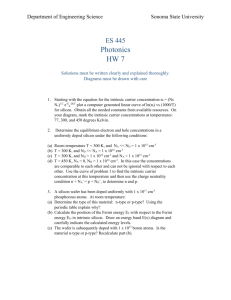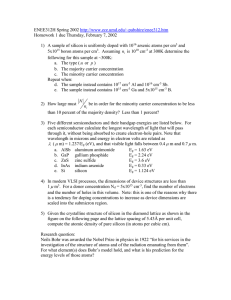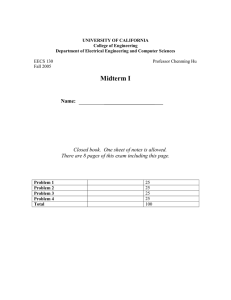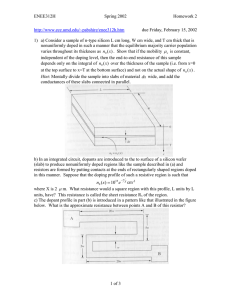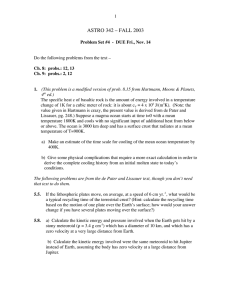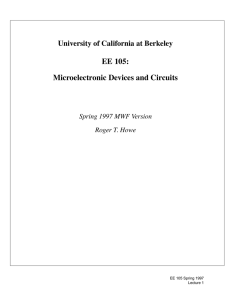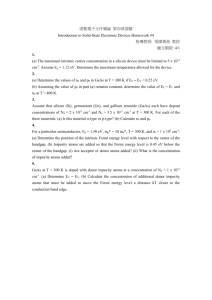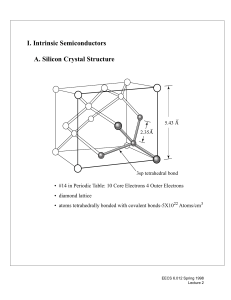PS1 Solutions
advertisement
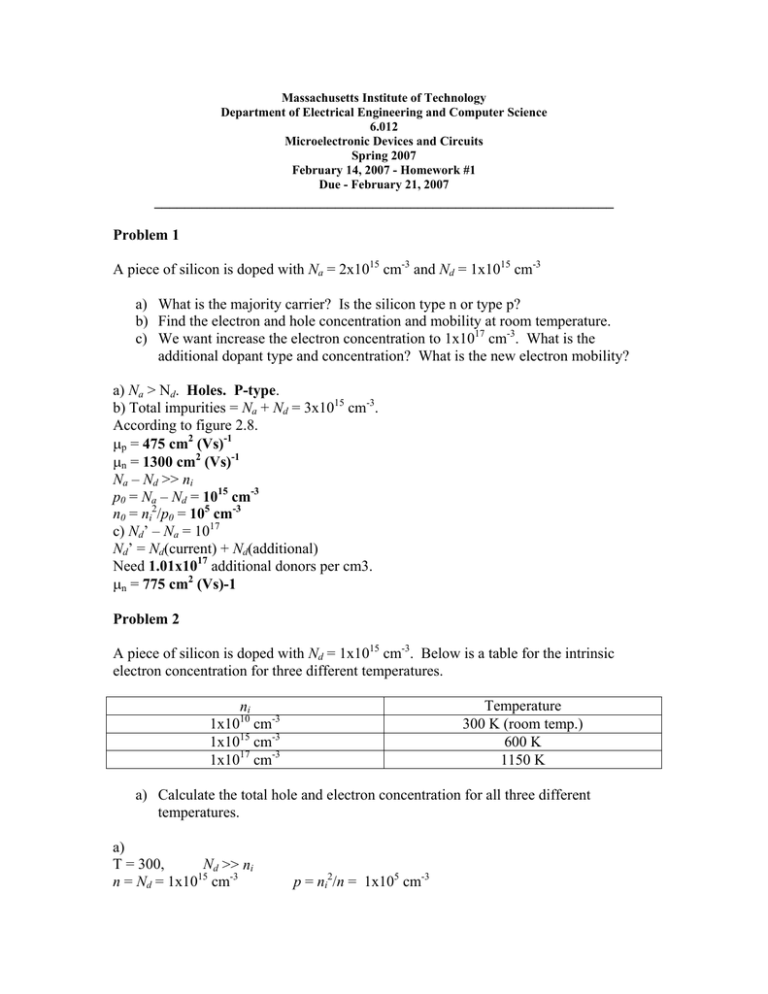
Massachusetts Institute of Technology Department of Electrical Engineering and Computer Science 6.012 Microelectronic Devices and Circuits Spring 2007 February 14, 2007 - Homework #1 Due - February 21, 2007 _____________________________________________________________ Problem 1 A piece of silicon is doped with Na = 2x1015 cm-3 and Nd = 1x1015 cm-3 a) What is the majority carrier? Is the silicon type n or type p? b) Find the electron and hole concentration and mobility at room temperature. c) We want increase the electron concentration to 1x1017 cm-3. What is the additional dopant type and concentration? What is the new electron mobility? a) Na > Nd. Holes. P-type. b) Total impurities = Na + Nd = 3x1015 cm-3. According to figure 2.8. µp = 475 cm2 (Vs)-1 µn = 1300 cm2 (Vs)-1 Na – Nd >> ni p0 = Na – Nd = 1015 cm-3 n0 = ni2/p0 = 105 cm-3 c) Nd’ – Na = 1017 Nd’ = Nd(current) + Nd(additional) Need 1.01x1017 additional donors per cm3. µn = 775 cm2 (Vs)-1 Problem 2 A piece of silicon is doped with Nd = 1x1015 cm-3. Below is a table for the intrinsic electron concentration for three different temperatures. ni 10 Temperature 300 K (room temp.) 600 K 1150 K -3 1x10 cm 1x1015 cm-3 1x1017 cm-3 a) Calculate the total hole and electron concentration for all three different temperatures. a) T = 300, Nd >> ni n = Nd = 1x1015 cm-3 p = ni2/n = 1x105 cm-3 T = 600, Nd ~ ni n = Nd /2 + Nd /2(1 + 4 ni2/ Nd2)1/2 = 1.62x1015 cm-3 T = 1150, Nd << ni 17 p = ni2/n = 1x1017 cm-3 n = ni = 1x10 cm-3 p = ni2/n = 6.18x1014 cm-3 Problem 3 Given a uniformly n-type ion-implanted layer with thickness t = 1 um and doping concentration Nd = 1017 cm-3. a) What is the sheet resistance? b) What is the resistance of the layout shown below? Assume that the contacts each contribute .65 squares. c) By adding additional dopants, we make a new n-type ion-implanted resistor with an average doping concentration Nd1 = 2x1017 cm-3 over the depth 0 < d < 0.5 µm and Nd2 = 1017 cm-3 over the depth 0.5 µm < d < 1 µm. Find the new sheet resistance. a)(qNdµnt)-1 = (1.6x10-19 x 1017 x 775 x 10-4) = 806 Ω/φ Note t = 10-4 cm. b) Total number of squares = .65x2 + 80/4 = 21.3 Resistance = Ωφ x number of squares = 806 x 21.3 =17.2 k Ω c) Think of this as two resistors in parallel; one on top and one on bottom. Ωtop/φ = (1.6x10-19 x 2x1017 x 600 x 5x10-5)-1 = 1041 Ω/φ Ωbot/φ = (1.6x10-19 x 1017 x 775 x 5x10-5)-1 = 1613 Ω/φ Total sheet resistance = (Ωtop/φ)//( Ωbot/φ) = 1041 x 1613 / (1041 + 1613)= 633 Ω/φ Problem 4 A slab of silicon has the following electron distribution. a) Assume thermal equilibrium. Plot the potential φ. b) What is the electron diffusion current density? Hole diffusion current density? Assume Dn = 2 x Dp = 26 cm2/s c) The hole and electron diffusion current densities do not sum to zero; however, the silicon cannot have a net current since it is an open circuit. Explain what is happening. Silicon Slab a) Using φ (x) = 60 mV * log (n(x)/1010) b) The slope of the line is 1016 – 1015 / 10-2 = 9x1017. Jdiff,n = qDn(dn/dx) = 26 x 9x1017 x 1.6x10-19 = 3.744 A cm-2 Assume room temperature, so p = ni2/n. To simplify the problem, assume that the hole concentration is also in a straight line. Using the endpoints, p(x=0) = 105 and p(x=10-12) = 104. Slope is -9x106. Jdiff,p = -qDp(dp/dx) = 0.5 x 26 x 9x106 x 1.6x10-19 = 1.872x10-11 A cm-2 Notice Jdiff,n >> Jdiff,p c) The voltage difference across the silicon produces a drift current that cancels out the diffusion current. Again, the electron drift current is much larger than the hole drift current because the electron concentration is much greater.

